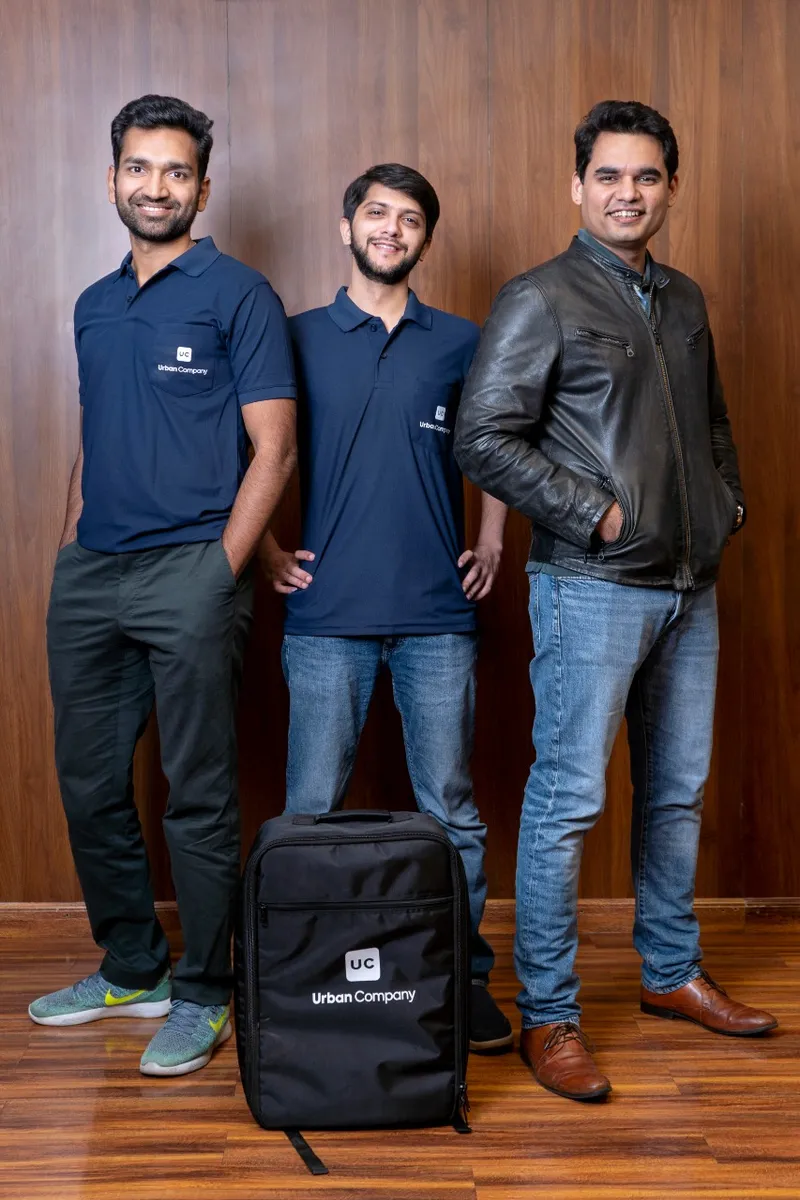In 2014, Abhiraj Singh Bhal, Varun Khaitan, and Raghav Chandra realised there was a gaping hole in the Indian home services market – a lack of transparency and credibility. All of us at some point have faced issues in finding the right plumber, electrician or beautician, and in getting them to attend to the services at the expected time.
It was with an aim to solve these problems that Abhiraj, Varun, and Raghav started UrbanClap, now known as Urban Company. As of October 2020, the startup has a presence in 22 cities in India, Australia, UAE, and Singapore. It has over 30,000 service partners, and more than 10,000 beauticians.

Founders of Urban Company
What does the platform do
During 2016-17, the home services market faced severe challenges. Several startups in the sector shut shop and faced serious funding crunch. Dunzo, which had a home services vertical, also shut down that part of the business, as it wasn’t contributing enough to the overall selections of the platform.
However, Urban Company and Housejoy survived the turbulence, and continued to provide their model and product use.
The Urban Company product was initially built by co-founder Raghav, and another engineer. The first product manager joined about five to six months into the journey; by the end of the first year, the team had three product managers, about 15 engineers, and one designer.
The team has now scaled to 100-plus engineers, a combined product and data team of more than 40 Product Managers, Data Scientists and a team of ten designers.
Kirat C, Product SVP, Urban Company, explains how the startup works today –
The company’s technology team is split into four functions – Engineering, Product, Design and Data. Additionally, the team is organised horizontally with four large work areas:
● Growth (customer traffic and virality, customer activation and retention, customer journeys)
● Marketplace (capacity and allocation, delivery and service experience, trust and safety)
● Supply (growth, on-boarding and training, supply retention and success)
● Platform (financing, experimentation system, data science system, etc.)
He adds that each of the above has several themes the team is working on. Each theme is staffed by a pod (composed of engineers, project managers, designers and data scientists, depending on the problem), working on relevant problems for several months.
Services marketplace
Initially, UC started as a services marketplace to connect customers with trusted service professionals. A customer could access the app, give their requirements, and the team matched them with a curated set of high-quality professionals. It was then up to the customer and the professional to take the service forward.
On the customer side, the company began with a mobile web version. On the service professional front, the team first launched an iOS version since they started with large-ticket creative categories (wedding photography, interior design, etc.), and most creative professionals were iPhone users.
“The first version took about two to three months. Early on, we embraced the JavaScript stack, so our mobile web frontend (Angular) and backend (Node.js) were both in JS. This helped us gain velocity with feature releases,” says Kirat.
“Since India is a mobile-first market, we chose a mobile-web version while our app was being readied. We built a separate booking model for standardised services, and a ‘connect’ model for customised ones. Also, we invested in improving the quality of ‘connect’ (launching an in-house chat), which helped boost conversions, and led to professionals seeing more value in working with us,” adds Kirat.
Early monetisation
Initially, Urban Company was led with a concierge model, but launched matchmaking soon after. This helped in giving fast responses to customers. In the concierge model, customers would request for the services they needed on chat.
“The faster our response, the higher the likelihood of customers choosing a professional on UC, rather than going offline. Additionally, we made our professional app mandatory from the beginning, which dramatically increased the speed of responses to customers,” says Kirat.
The team also monetised the platform within a year of their launch. This helped in validating the business model (“nothing works better than charging money to validate your business model” according to Kirat), making them realise the value they were providing via different services.
The team ran the MVP product for three to four months until they had to build:
a. More platforms (customer and partner side apps) to scale in terms of new user growth.
b. More systems to reduce manual operations, for example, the UC matchmaking engine.
Besides, the team began investing in features to improve connectivity between customers and professionals, so the latter had a higher conversion. “We built an in-house chat product. Within a year, we also built the first version of our engine to monetise the platform,” says Kirat.

The Urban Company Team
Breaking the categories
Soon, the team realised the market had two categories. First, customised services typically with a high order value and a longer purchase period. Second, standardised services with lower order values and a short, more immediate purchase period. Wedding photography, interior design etc. were part of the first bucket, while salon, spa, plumber, electrician were in the second.
“Thereafter, we built different user journeys. In the first category, we would connect the user with a curated list of three to five relevant professionals. In the second case, we opted for the full-stack approach wherein we dispatched a professional to the customer’s house,” explains Kirat.
The team soon realised that customers were happier with the full-stack model. Price transparency, standardised procedures, guaranteed fulfilment and a well-trained fleet of professionals all added to the package.
The full-stack model
“Therefore, we decided to shift from the connect model to a full-stack, fulfilment model. Those services where we could not transition to full stack, we made sure to discontinue them. Going full-stack meant extensive investment in our partners with respect to training, micro-financing, access to branded products and tools and more, so that our customers could receive delightful services every time, irrespective of the professional delivering the service,” says Kirat.
The decision in pivoting to a full stack model dramatically improved our customer and partner retention rates. This is reflected in UC’s customer app being rated 4.6 on both the Play Store and App Store.
“An interesting but major business solution was shutting down our lead-gen model, and pivoting to full-stack, which was a difficult but rewarding decision. Business revenues were split roughly 50 percent between the two business models but NPS (Net Promoter Score) and retention figures favoured a standardised booking model. The realisation that customers wanted the whole deal from confirmed fulfilment, price transparency, genuine products, service SOPs and more, made us pivot to full-stack,” says Kirat.
But to pivot to full stack, Kirat explains the team had to build the partner app extensively as well. This included building out multiple capabilities for our partners including a financing product, a partner supply chain for consumables along with partner ordering, app-based training centres along with video conferencing capabilities, SOP flows and more.
Working along the supply side
One key area of investment early on was to unlock professional supply. Cold-calling busy professionals and asking them to download and register on what was then a lesser-known app was exceedingly arduous.
UC experimented with many strategies, including manually sending customised SMS-es to professionals to join the platform. Soon, it was apparent the best way to reach out to a prospective professional was with the actual customer request or order. Kirat adds,
“Consequently, we shifted from a push model to a pull model for attracting supply. We experimented by sending business leads in real-time to professionals after masking customer details. As it turned out, this worked better than any manual sales call. Moreover, we discovered that the speed of response on a customer request was one of the key drivers to higher conversions on the platform. Overall, these insights helped in the scaling of tech.”
But building systems for a set of distinct services is an ongoing challenge. Kirat explains they want to build horizontal, cross-category, scalable systems, but many times the categories have distinct nuances.
“Our approach has been to “solve keeping a specific category in mind but build in a generic fashion”. Nevertheless, there was a time when our technology stack for customised and standardised services diverged. Through trial and error, we’ve realised that the adage you ship your org chart is true,” says Kirat.
To ensure the overall stack does not diverge, the team has built a layer of horizontal capability teams as the base layer of our tech org, and are building category teams on top.
What can we expect?
According to the team, they are now going through the next product evolution where they have built a set of horizontal capabilities that serve all categories (e.g., shopping cart, dispatch, fulfilment, invoicing, etc.).
Kirat says they are going deeper into categories and building specific capabilities for each. For example, diagnosis and revisit capabilities for appliance repair, beauty regimen recommendation for beauty categories, surveying and project management capabilities for painting, etc.
“Meanwhile, we are catering to different geographic nuances. For example, international customers get their cleaning services when they aren’t at home. So we have had to rethink our payments stack. Also, international customers prefer getting cleaning services weekly or bi-weekly, so we have built easy scheduling and rebooking capabilities,” says Kirat.
Globally, the online, on-demand home services market is expected to grow at a 52 percent CAGR between 2018 and 2022, according to a report by TechNavio.
And despite the challenges surrounding standardisation of on-demand services, the lack of consistency, and through customer complaints, the trio realised they had chanced upon the opportunity to revolutionise the flagging sector, with the right technology.
The Urban Company team is betting big on some new categories and additions to the core business:
- New Category Build: Here the team focussed on – What does a great, category-defining tech-led experience look like for categories like painters, maids, packers and movers, tutors and such? These are either not present or still new on the UC platform.
- 10x Service Experience: What does a 10x service experience (and customer journey aided by technology) look like for categories such as salon services for women, men’s haircut and grooming at home, appliance repairs, etc.? For example, video consultations for beauty needs, remote diagnosis for appliance repairs.
- Supply Growth Engine: How do they ensure the next 100,000 professionals are screened, on-boarded, trained and kitted-out with minimal physical intervention? How do they build the largest blue-collar worker database – the LinkedIn for blue-collar workers?
- Training as a Service: How to build out and monetise the training capability (having run tens of thousands of training sessions for service professionals) not just for UC professionals but for everyone – be the Coursera for service professionals.

![You are currently viewing [Product Roadmap] UrbanClap to Urban Company](https://blog.digitalsevaa.com/wp-content/uploads/2021/03/PRM-1616488895708.png)







